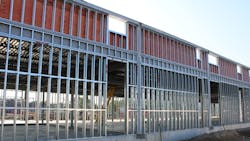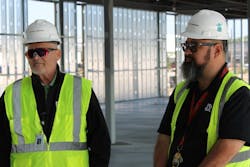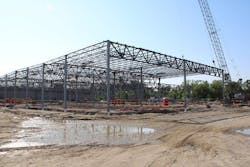Significant progress made on new Coolidge Terminal facility
Significant progress has been made on the new Coolidge Terminal facility, including the start of construction on an operations and administrative building, which will feature state-of-the-art amenities for Detroit Department of Transportation (DDOT) employees.
The 200,000 square-foot, three-building terminal complex will provide a base for operations, maintenance and storage for DDOT. The facility will have the capacity to house a total of 144 buses with future expansion to house and maintain a total of 216 buses and will have 245 parking spaces. The previous Coolidge Terminal stopped operating after a fire in 2011. The new facility, which will also replace DDOT’s aging Gilbert Terminal, will become DDOT’s new west side base of operations for drivers and mechanics. The eastside base will continue to be the Shoemaker Terminal near I-94 and Conner.
“Coolidge Terminal is an investment which will improve DDOT service for our residents and create a great working environment for our employees,” said Detroit Mayor Mike Duggan. “Thanks to the Biden-Harris Administration and the state of Michigan for the funding needed to bring DDOT into the 21st century.”
The new Coolidge Terminal facility will consist of three primary buildings:
- An operations building
- Bus storage and coach services building
- A fleet maintenance building
The facility will feature a site plan that contains details for future expansion of each operation. The 16,922 square-foot operations building will serve as the main point of entry for employees and visitors arriving by automobile, bicycle or walking. The operations building will also house employee locker rooms, administrative and training space and radio dispatch. The bus storage and coach services building is 121,192 square feet and will house the buses for daily cleaning and fueling.
North of the bus storage building is where the 54,293 square foot fleet maintenance building will be located. The location will permit deliveries to take place without interrupting bus circulation. Inside of the building, buses will receive regular servicing and maintenance, such as fluid changes, tire changes and mechanical work.
“The progress-to-date on the re-building of the Coolidge Terminal is remarkable. This state-of-the-art facility for operations, maintenance and administration will enhance the work experience of Transit Equipment Operators and General Automotive Mechanics,” said DDOT Interim Director G. Michael Staley. “Sufficient space and numerous amenities should create a work environment where employees can be their best. The incorporation of new technology in maintenance and operations will improve service efficiency producing a direct benefit to the passengers that DDOT transports every day.”
As part of the site research, DDOT surveyed the surrounding area to ensure existing traffic, pedestrian crossings and business accessibility would not be negatively affected.
The new Coolidge Terminal project is being led by the Detroit Building Authority, which also managed the adaptive reuse of the former State Fair Dairy Cattle Barn near 8 Mile and Woodward, which is now DDOT’s new Jason Hargrove Transit Center.
“The DBA is pleased with the construction progress made by the project team on this state-of-the-art bus maintenance facility, which happens to be one of the largest capital projects the city has seen,” said Detroit Building Authority Deputy Director Donna Rice. “Collaboration amongst all stakeholders, including city departments and the support from the community, is the reason the project is coming to fruition."
Sustainability efforts
DDOT notes each building’s architectural, mechanical and electrical systems are designed to use requirements meeting or exceeding the Michigan Energy Code. Such items include use of LED lighting fixtures, lighting controls systems with occupancy sensors and time clocks, energy efficient windows and skylights, as well as high-performance precast concrete insulated wall panels. The light sensors in the buildings will detect how much light to emit based on the amount of natural light coming from windows and skylights. This system promotes energy efficiency while helping to improve workplace morale and health.
According to DDOT, throughout the construction process, approximately 35,000 tons of existing concrete pavement and foundations from landfills have been recycled back into structural backfill material. The concrete is enough to cover a football field to a height of around 14 feet. The site also features a storm water management plan to be implemented through use of various bioretention basins and underground detention basins.
Funding
The total cost of $160 million project (including approximately $10 million for demolition of the existing terminal) is coming from the following sources:
- $102.5 million - Federal Transit Administration
- $31.5 million – City funding
- $25.6 million – Michigan Department of Transportation


